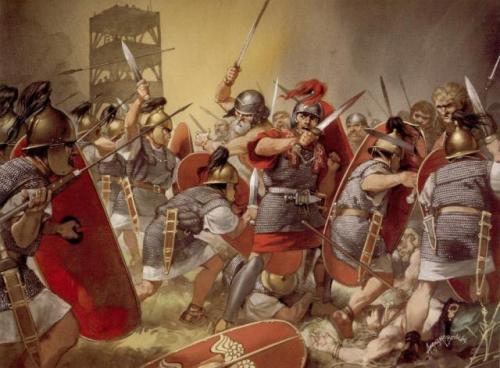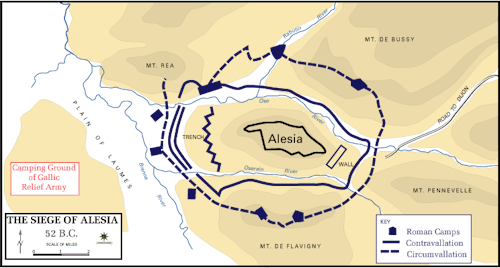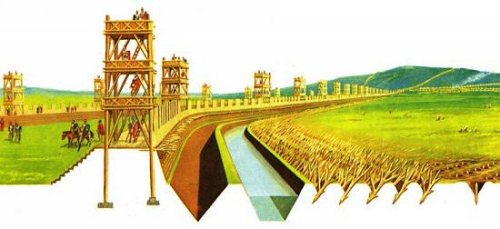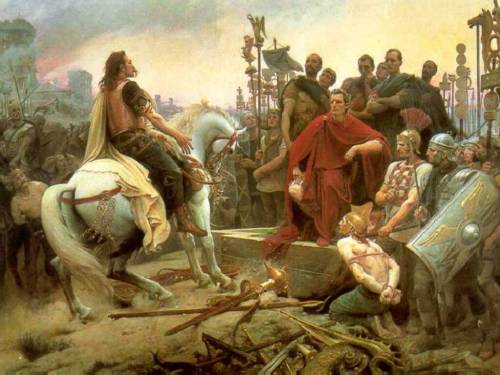peashooter85:2,065 years ago today — Roman forces under Julius Caesar are victorious at the Battle o
peashooter85:2,065 years ago today — Roman forces under Julius Caesar are victorious at the Battle of Alesia. Between 59 BC and 52 BC the Roman General Julius Caesar had conquered much of Gaul, now modern day France. When it seemed nothing would stop Ceasar’s Legions, a Gallic chieftain named Vercingetorix united the Gallic tribes and declared himself king of a united Gaul. After having one of his legions ambushed and destroyed by the Gauls, Caesar struck back and drove Vercingetorix’s forces to the north.By August of 52 BC, Vercingetorix and his Gallic army of 80,000 had been forced to take shelter at a heavily defended hill fort in Northern France called Alesia, now modern day Alise-Sainte-Reine (possibly, historians debate this). The fortress was positioned on the middle of a large hill, was well fortified, and occupied an important defensive strategic position. Caesar knew that with 60,000 men he did not have enough troops to storm Alesia. At the same time he could not retreat, lest he expose his forces to reprisal.Rather than conduct a frontal assault, Caesar decided to lay siege to Alesia and starve the Gauls into submission. To ensure that no one could leave Alesia, Caesar ordered the construction of a large 11 mile timber wall to surround the fortress. Incredibly, the wall was completed in less than three weeks, complete with trenches, moats, deadfall traps, and other obstacles. As the Roman’s worked word spread throughout Gaul that Vercingetorix and his forces were in trouble. Warriors from all over the land gathered to lift the siege, and soon a force of around 125,000 - 250,000 Gallic warriors marched toward Alesia. To counter the Gallic relief force, Caesar ordered the construction of an identical outward facing wall that was over 13 miles long. Meanwhile in Alesia, things were growing desperate as food supplies began to run low. Vercingetorix had a strategy to break the siege, he expelled all women and children from the fortress in order to save food for the warriors. It was hoped that Caesar would open his lines to let them through, creating a momentary weakness in the Roman forces which he could break through. Caesar, however, was not fooled by the trick, and ordered no mercy for the Gallic women and children. Forgotten and neglected, the Gallic women and children died of starvation and exposure in no man’s land.Finally, by the end of September the Gallic relief force had arrived, and the Romans found themselves under siege in between two large Gallic armies. With tactical superiority and greater numbers, Vercingetorix formulated a strategy that would surely provide for a breakthrough. While simultaneously attacking from the outside and inside of Alesia, the Gauls would assault a point northwest of the walls where the lines were the thinnest and weakest. Over the next 3 days the Gauls attacked day and night on that one point. While the Romans were greatly outnumbered by the fierce Gauls, superior Roman tactics, discipline, equipment, and organization won the day, halting each Gallic assault. Despite several successes the Romans were growing tired while also running short on food. At one point Caesar himself had to take foot and rally his men, personally leading the defense from the front. However Caesar knew it was only a matter of time before the Gallic hordes overwealmed the Roman defenses. On the third day of the battle, Caesar orchestrated a audacious plan.During the Gallic assault on the third day, Caesar took a force of 13 cavalry cohorts, rode behind the Gallic relief force, and counter-attacked from the rear. Surprised by the Roman flanking maneuver, the Gallic charge quickly collapsed into a panicked retreat. The disarrayed Gallic army was easy prey for the disciplined Roman counter-advance, and thousands of warriors were cut down until as Caesar himself put it, only the complete exhaustion of the Romans saved the Gauls. The Romans suffered heavily, losing over 12,000 men. The Gauls, however, lost between 50,000 and 90,000 warriors, with tens of thousands more captured and taken as slaves.The next day, October the 3rd, 52 BC, Vercingetorix surrendered to Caesar. The Roman victory at Alesia would signal the end of the Gallic Wars and the rise of Julius Caesar. Over the coming decades Gaul would be pacified into a Roman Province, remaining so for the next four hundred years. Julius Caesar became the most celebrated man in the Roman Republic, a household name throughout the Roman world. However, when the Roman Senate ordered Caesar to stand down, Caesar decided he was destined for bigger things. With his army Caesar overthrew the Roman Republic, and declared himself “dictator for life”. Unfortunately the Senate was not very happy with this, and Caesar was stabbed to death on the Senate floor on the Ides of March, 44 BC.The fate of Vercingetorix was even worse. Taken as a slave to Caesar, he was exhibited in a triumph (military parade) and ritually strangled to death at the Roman forum in 46 BC. (Possibly, he may have also been strangled to death in his cell after the triumph).Did not happen today, but reblogging because of the Ides of March. -- source link
Tumblr Blog : peashooter85.tumblr.com



